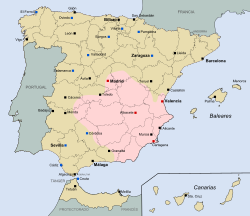Final offensive of the Spanish Civil War
| Final offensive | |||||||
|---|---|---|---|---|---|---|---|
| Part of the Spanish Civil War | |||||||
 Map of Spain in March 1939.
|
|||||||
|
|||||||
| Belligerents | |||||||
|
|
|
||||||
| Commanders and leaders | |||||||
| Negrín's government: Council of National Defense: |
|
||||||
| Strength | |||||||
| 250,000 –500,000 men 40 aircraft |
1,000,000 men 600 aircraft |
||||||
| Casualties and losses | |||||||
| Casado's coup: 230 – 2,000 dead Final offensive: 150,000 captured |
1,223 dead (sinking of the Castillo de Olite) | ||||||
The final offensive of the Spanish Civil War took place between 26 March and 1 April 1939, towards the end of the Spanish Civil War. On 5 March 1939, the Republican Army led by Colonel Segismundo Casado and the politician Julián Besteiro rose against the Socialist prime minister Juan Negrín and formed a military junta, the National Defence Council (Consejo Nacional de Defensa or CND) in order to negotiate a peace deal. Negrín fled to France but the Communist troops around Madrid rose against the junta, starting a civil war within the civil war. Casado defeated them and started peace negotiations with the Nationalists. Francisco Franco, however, was prepared to accept only an unconditional surrender. On 26 March the Nationalists started a general offensive and by 31 March they controlled all Spanish territory. Hundreds of thousands of Republicans were arrested and interned in concentration camps.
After the fall of Catalonia in February 1939, the military situation of the Republic was hopeless. The Republic still had the capital city and 30 per cent of Spanish territory, but it had lost 220,000 soldiers, the second city of the country, and the industrial resources of Catalonia. Furthermore, on 27 February Manuel Azaña, the president of the Republic, resigned and the United Kingdom and France recognized the Nationalist government.
The Republican army still had between 250,000 and 500,000 men, but had only 40 aircraft (three Natasha and two Katiuska bomber squadrons, and 25 Chatos and Moscas fighters), little artillery and few automatic weapons. Many soldiers were unarmed (in December 1938 the Republican army had only 225,000 rifles), and lacked shoes and overcoats. In Madrid, there was food for only two months, and no water, heating, medicine or surgical dressings. On the other hand, the Nationalist army had more than a million men at the end of 1938; among them 35,000 Moroccans, 32,000 Italians and 5,000 Germans, plus 600 aircraft.
...
Wikipedia
